Our 2024 State of Marketing & Trends Report went live earlier this year, and I recently dug into the data and compiled a list of key marketing recommendations for this upcoming year to answer common questions like:
- Which industry trends and tactics are marketers investing in?
- What challenges are they facing?
- And, what are their plans and expectations for 2024 and beyond?
Let’s dive into my recommendations.
11 Data-Backed Marketing Recommendations for 2024
1. Produce short-form videos.
Our survey included more than 1,400 global B2B and B2C marketers, and over half of them told us that they’re leveraging short-form video in 2024, and it’s the format they plan to invest the most in this year. Moreover, it offers the highest ROI of any other content format.
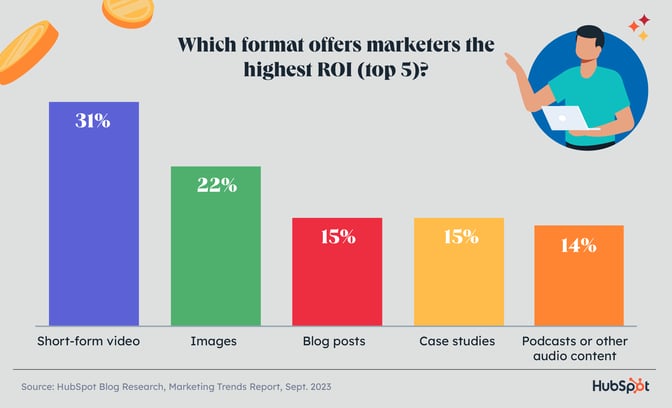
Short-form video is also incredibly effective with consumers. While I’ve yet to buy something on social media (I’m afraid of scams), the draw is certainly there for me and my consumer peers — 56% of them say they’ve bought something based on an ad they saw on TikTok.
So, why do consumers engage more with short over long-form content? When done right, short-form content is quick but concise, enabling fast-paced web users to quickly get most of the information they need. And, if a short-form video doesn’t pack all the information a person needs to convert, it usually forces marketers to point out the most important facts that will make viewers eager to learn more.
I think Miss.Excel (a company that offers Microsoft Excel courses) is a great example of using short-form videos on Instagram. In this quick video, its founder and CEO, Kat Norton, demonstrates her credibility as an Excel coach by showing viewers how to convert a list of names in all caps to proper text.
If you plan to leverage short-form content in the next year, read up on the latest trends and tips from experts in the video space to get inspiration for your strategy.
2. Make it easy to buy from you online.
We’ve written about social selling a lot here on the HubSpot Blog, but with good reason — it’s the new frontier for reaching consumers. Every time we re-run our Consumer Trends Survey, the number of people who look to social media to find products increases.
Those same users also buy products on social media, and 17% of social users bought a product in-app in the past three months.
Since consumers love it, marketers do it, and it pays off. They’re driving more sales on social media than in past years, and almost half of the marketers responding to our survey will increase their investments in social media shopping tools this year.
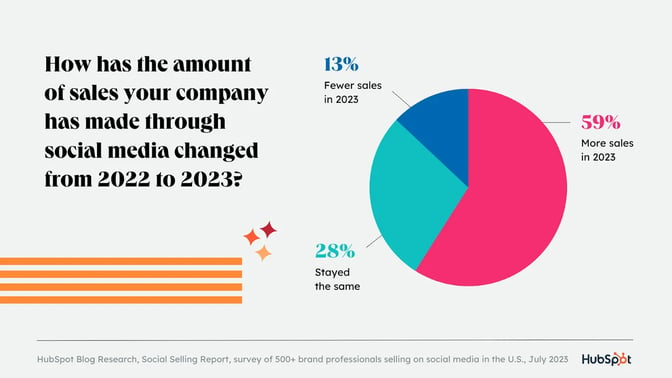
As a result, one of my top recommendations in 2024 is to build a social selling strategy that makes it easy for people to buy from you on social media if it makes sense for what you sell. (SaaS businesses, please stay away from TikTok Shops).
However, whether you’re new to selling on social or improving your strategy, you won’t be successful without building trust.
My generational belonging tells me that I should be jumping at the chance to buy on social media, but I’m skeptical of it, as are 53% of consumers. This blog post about building trust with social selling is a great resource if you use the strategy.
3. Partner with micro-influencers.
Nearly 90% of influencer marketers say influencer marketing was effective for their company in 2023. We’ll only see it grow throughout 2024 as half of those using it plan to increase their investments.
The standout change in influencer marketing these past few years is that marketers find the most success with micro-influencers with 10,000 – 100,000 followers.
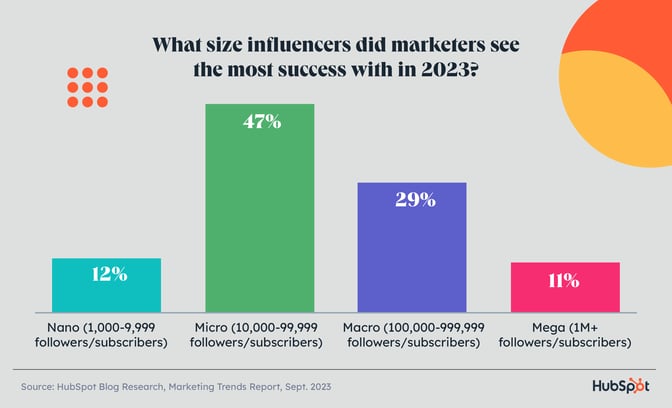
As a marketer, this makes sense. These influencers are more affordable and, most significantly, have the most tight-knit and engaged communities. As a result, micro-influencers can offer more persuasive and effective product or brand endorsements.
This also makes sense to me as a consumer. I trust and relate more to the smaller influencers and creators I follow, much more so than those with millions and millions of followers.
And, as much as people might like to say that they make their own product decisions, influencer marketing works — last year, one in four consumers bought a product based on an influencer’s recommendation.
Want to leverage influencer marketing but don’t know where to start? Check out this handy checklist.
4. Bolster your SEO with thought leadership.
Google’s redefining of helpful content and adding “experience” to the existing expertise, authority, and trust (E-A-T) framework were among the biggest SEO changes in recent years.
Now, content that ranks best is most often created by those with experience and expertise in the subjects they write about, and they use unique personal experiences and anecdotes to give it the authoritative push it needs to stand out from the crowd.
On the blog team, we feel that the best way to bolster your SEO in this “new era” of search is with subject matter experts (SMEs) and thought leadership. These people have significant experience, expertise, and authority in their niche and can provide readers with helpful and actionable information.
A great way to include SMEs and thought leaders in your content is people within your organization who have experience in the subjects you write about. If they’re not writers, ask them to contribute quotes you can feature in your blog content.
5. Do more with AI and marketing automation tools.
I know you’ve read this sentence a million times, but I’m saying it anyway — AI and automation were everywhere last year. I did get a bit of AI fatigue, but the fact is that they’re helpful tools, no longer higher-priced, inaccessible technologies only used by giant corporations.
62% of marketers say AI and automation are important to their marketing, and they can help with most things, from running complex predictive analytics reports to personalizing marketing emails to simply streamlining basic tasks to give marketers more time for complex strategies or tactics that require the human touch.
Doing more with AI will be a marketing theme throughout 2024, and I recommend giving it a shot if you haven’t already, especially since there are many use cases:
- AI can be your content marketing assistant. Generative AI tools can help you create compelling, on-brand, and high-performing marketing content. 81% of marketers using gen AI say it effectively assists them in their role.
- AI can help you be more effective with your data. Feed your crucial marketing data to an AI tool to quickly analyze campaign performance and identify trends to be aware of. 6 out of 10 AI and automation users analyze data with AI.
- AI gives you time back to be more creative. Marketing is a creative role, but sometimes, we don’t have much time to be creative because of other required day-to-day tasks. It might be exciting to learn that marketers save and get back an average of 2.5 hours per day by incorporating AI tools into their processes.
Any recommendation I give for AI and automation also comes with a disclaimer: the tools you use shouldn’t be your replacements. Instead, I recommend working with your AI and viewing it as a trusty sidekick that will help you maximize your efficiency. Sean Downey, Google’s President, Americas and Global Partners, told HubSpot, “It isn’t about the technology itself. It’s about what you, as marketers, will do with it. AI can’t do anything without you — but you can do so much more with AI.”
Image Source
6. Champion social responsibility.
Consumers care that the brands they support are committed to social responsibility. They want to buy from brands that share their beliefs and attitudes, and their likelihood of purchase because of a brand’s commitment to diversity and inclusion jumped 17% from last year.
As a business, when you tell consumers about your values, you:
- Build deeper connections with audiences with the same interests,
- Fosters trust and loyalty,
- Stand out from the competition and attract new customers looking to patronize businesses that share their values.
Sharing this kind of content pays off, as marketers report it offers the second-highest ROI of all the trends they leverage, and most plan to invest more in it this year.
If you take anything away from this recommendation, though, let it be this: the content you share or commitments you make to social responsibility need to be genuine. Consumers can recognize fake appeals and won’t let you get away with it; they might even call you out for it online.
7. Leverage audio for engagement rather than ROI.
Audio-first platforms like Clubhouse have popped up in the last few years, and apps like Spotify have added more live audio features. The quick jump in popularity showed us just how viral audio content can be, even when branded.
And, in 2024, it’s still worth keeping on your radar. On the consumer side, 75% of Americans ages 12+ have listened to online audio in the past week.
With marketers, podcasts or other audio content are not among the most leveraged trends, nor do they offer the highest ROI, but investments will continue to grow in 2024:
- 39% of those who already leverage podcasts or other audio content will invest more in 2024
- 42% of those leveraging audio chat rooms plan to invest the same amount in 2022.
- Podcasts or other audio content are the top media formats marketers plan to leverage for the first time in 2024.
Why is this marketing format still so popular if it doesn’t offer the highest ROI?
My teammate Caroline Forsey spoke to Dan Stillgoe, Blend’s Marketing Manager, and he said it well: “It’s true you can’t directly attribute leads or revenue from a podcast, but that‘s not its purpose. Podcasts are a long-term brand-building channel that can improve affinity and connection for your brand like no other channel…Podcasting is the perfect way to craft content that’s engaging and authentic.”
Podcasts stand out to me, as a consumer, for their authenticity. Yes, hosts do research, plan episodes, and write out talking points, but I don’t get that kind of natural, free-flowing conversation from any other media I consume.
And, as Stillgoe mentioned, podcasts are a great way for your business to become a trusted voice and thought leader in your space. It’s not a true “behind-the-scenes” look, but hearing someone speak gives your business a human voice, which goes a long way in building a connection with listeners.
8. Use an omnichannel approach.
Marketers leverage an average of four platforms in their role, and Facebook (57%) and Instagram (55%) are the most popular. The two also tie for the highest ROI.
But those are just two of many platforms, so how do you pick? I recommend these two guiding questions:
- Where are your audiences spending time? You’ll post into the void if you focus on a channel your audience isn’t on. Our Consumer Trends Report will tell you where your target audience groups are.
- How many people are on your team? Fewer hands mean choosing the most effective platforms for your business needs instead of more platforms to maximize your impact and ROI.
I know that a challenge to using multiple platforms is having enough content to share on each one. In a separate Social Media Trends Survey, we found that marketers usually share similar content across all platforms with small tweaks to tailor it to each platform. This means you aren’t pressed to create new content for every channel because you can repurpose what you already have.
9. Align sales and marketing teams.
Organizations with tightly aligned sales and marketing teams see 27% faster profit growth and 36% higher retention.
Despite its importance, aligning with sales is one of the top challenges marketers face, most significantly because of a lack of communication and needing to be clearer about overall goals and strategy.
Monica Elgemark, Chief Marketing Officer at Oneflow says that, to address the challenges of sales and marketing alignment, “It’s imperative to define clear goals and objectives that both sales and marketing teams can rally behind. Clear goals and objectives that differentiate between awareness and revenue should be considered for both sales and marketing to understand the values different campaigns bring. It is a mutual dependency between these areas that needs respect.”
10. Make the most of your marketing budget.
Most marketers had their budgets remain the same between 2022 and 2023, likely because of the economic business landscapes accelerated by the pandemic.
For example, businesses with high-priced products saw a lack of sales floor performance as decision-makers needed to spend more cautiously. Meanwhile, online marketing provided exceedingly solid traffic and conversion opportunities as consumers and prospects were stuck inside on the web.
Marketers still say their budgets will remain the same this year, but they expect budgets and resulting ROI will be scrutinized somewhat more now than in the past, likely due to economic events of the past few years. Business leaders have placed more importance on how and why money is spent as it is to maximize efficiency.
If you‘re on a team receiving more eyes, I understand how you may feel strained to be as effective as possible, especially if you’re hoping to justify more budget in the future. I recommend reading this blog post about managing your entire marketing budget and downloading our free budget planning templates to help you plan your own.
11. Focus on building hybrid strategies.
45% of the global marketers we surveyed are hybrid employees, while just 24% are fully remote. Employees are not rushing back to the office full-time, so as you plan for 2024, consider building strategies that work best for a dispersed workforce.
Not only that, but hybrid is the most popular work model (preferred by 41% of employees), followed by remote (32%), with in-person coming last (27%).
The good news? Offering flexibility could result in great employee or team retention. The top reason people we surveyed want to stay in their jobs is to maintain their flexible work schedule, beating out competitive pay.
Want more recommendations?
This isn’t our only recommendation post leveraging our Marketing Industry Trends Survey data. To help you dive deeper into data-backed tactics, we’re continuing to publish content around specific findings, trends, and strategies highlighted in our survey.
Below are just a few of the posts we’ve written recently about specific trends and tactics discovered in our research.
Need even more guidance for your marketing planning? We’ve got you covered with the free resource below.
Looking for even more insight? Dive into more data-backed recommendations, trends, and yearly predictions with the free resource below.

![Download Now: Free State of Marketing Report [Updated for 2024]](https://no-cache.hubspot.com/cta/default/53/db725f24-564c-483b-a28c-2d6ff9986516.png)

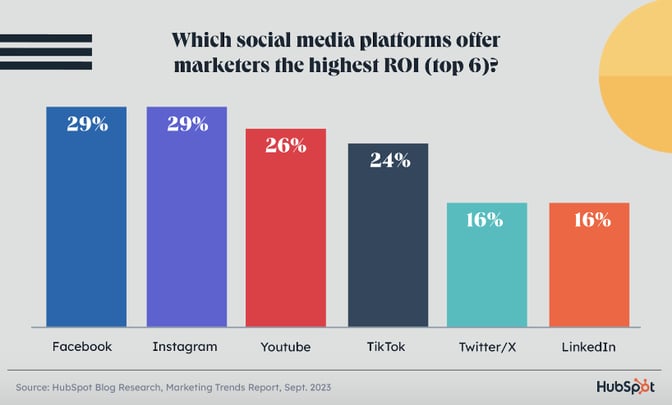
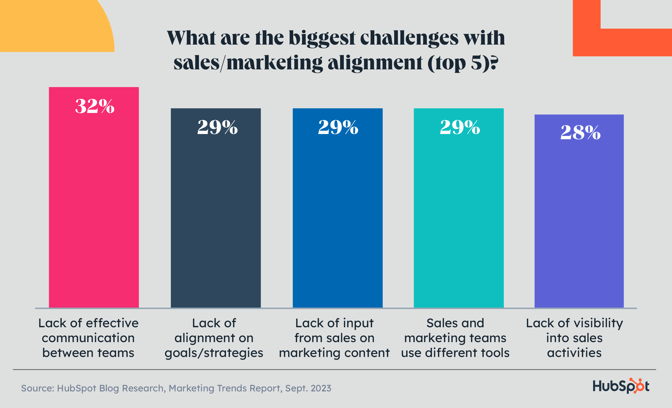

![11 Recommendations for Marketers in 2024 [New Data]](https://seths.blog/wp-content/uploads/2018/06/seth_godin_ogimages_v02_18061314.jpg)
![11 Recommendations for Marketers in 2024 [New Data]](https://blog.hubspot.com/hubfs/website%20designs.png#keepProtocol)
![How to Optimize for Google’s Featured Snippets [Updated for 2024]](https://moz.com/images/blog/Blog-OG-images/How-to-Optimize-for-Googles-Featured-Snippets-OG-Image.png?w=1200&h=630&q=82&auto=format&fit=crop&dm=1724004002&s=13df73104762982790dab6dc8328023f)


